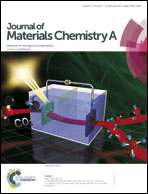Promotion of strongly anchored dyes on the surface of titania by tetraethyl orthosilicate treatment for enhanced solar cell performance†
Abstract
Tetraethyl orthosilicate (TEOS) is employed as an equilibrium shifting agent for the esterification reaction between the carboxylic acid of the amphiphilic Z907 dye and Ti-OH on the mesoscopic TiO2 surface in dye-sensitized solar cells (DSCs). We demonstrate that TEOS treatment of the Z907-dyed TiO2 film increases the amount of strongly anchored dyes, and also improves the electron diffusion length (Ln). Consequently, the cell provides a remarkable short-circuit current density (Jsc) enhanced by 22% (9.0 → 11.0 mA cm−2) and the total power conversion efficiency increased by 14% (4.9 → 5.6%) under 1 sun (AM 1.5, 100 mW cm−2), even with less than half the amount of adsorbed dye as compared to the reference. Therefore, TEOS treatment seems to be effective in increasing the power conversion efficiency along with increasing the concentration of the strongly anchored dye, specifically when using an amphiphilic dye such as Z907.


 Please wait while we load your content...
Please wait while we load your content...